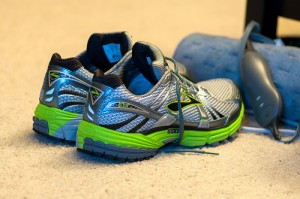by Michelle Sutton-Kerchner
Don’t let heartburn and indigestion corrode your workout. Avoid painful flare-ups. Follow these preventative tips …
Exercise often helps alleviate stomach pressure from bloating and gas. When constipation is an issue, the movement of exercise helps ease waste from the body. One study showed constipation significantly improved from moderate exercise for 30 minutes a day, compared with a sedentary group. Combined with proper diet, exercise can be a remedy for gastrointestinal conditions like irritable bowel syndrome (IBS) and Crohn’s disease (low-intensity exercise). It can soothe anxiety that troubles a nervous stomach.
Gastroesophageal reflux disease (GERD) is a condition where acid refluxes from the stomach up the esophagus. Exercise can reduce the likelihood of developing GERD, by helping maintain a healthy weight. Unfortunately though, symptoms sometimes interfere with one’s ability to exercise. Athletes, especially, are at risk for GERD flare-ups due to the intensity of their workouts. No need to forfeit the game! If it doesn’t stop famous Olympians who suffer from GERD, it should not stop you.
The Cause

This backwash of acid causes burning pain (heartburn), nausea, sour taste, and sometimes vomiting. Heartburn and indigestion are common offenders everyone experiences on occasion. (No need to remind you of that spicy taco fest or large milkshake at bedtime.) However, if these symptoms occur at least twice weekly and interfere with regular functioning, physicians usually diagnose them as GERD. Unlike the lining in the stomach, the esophagus is not protected. Left untreated, this acid can cause permanent damage to the lining of the esophagus.
Symptoms
The most common symptom is frequent heartburn. Other signs include:
- difficulty swallowing (dysphagia)
- nausea and vomiting
- dry cough and hoarseness
- sensation of a lump in the throat
- feeling that food is caught
- asthmatic symptoms, such as coughing and wheezing
- dyspepsia: pain and discomfort in the upper abdomen, bloated stomach, and nausea after eating.
Whenever chest pain is involved, take precautions. If accompanied by jaw or arm pain, or shortness of breath, seek immediate medical attention. This can indicate a heart attack.

Asthma and GERD are often partners in crime. They may occur together, one exacerbating the other. Identifying triggers for both can be tricky in this instance. Treating one may help the other. However, certain asthma medications can worsen acid reflux.
An allergist may wish to try an over-the-counter acid reducer to discover any affect it may have on asthma control. A food journal can be helpful for tracking symptoms related to both. Acidic foods can trigger GERD symptoms. Food allergies or sensitivities can trigger asthmatic reactions.
Why Athletes Are a Target
Stress on the abdomen, common during exercise, may cause those athletes predisposed to GERD by a leaky esophageal sphincter (a muscle that keeps stomach acid out of the esophagus) to incur reflux during intense physical activity. Exercise also reduces blood flow to the digestive tract, which causes the stomach to produce more acid in efforts to break down any food consumed.
An overachieving athlete may be prone to strains and injuries from excessive efforts. Increased bodily stress and anti-inflammatory usage can exacerbate GERD symptoms. Excessive reliance on sugary sports drinks also may be a trigger commonly associated with the highly trained exerciser. Water down these beverages when possible.
Although the exact association is unknown, research indicates heartburn symptoms may occur in about half of all athletes. There is a direct connection between the intensity and timing of exercise and the onset of symptoms. The journal Medicine and Science in Sports and Exercise reported weightlifters had higher measurements of acid reflux during an 80-minute exercise period than long-distance runners and cyclists.
GERD-friendly Workouts
Certain exercises should be avoided when acid reflux is troublesome. Common sense can guide you on the basics. Save high-impact workouts for when your stomach is more stable. Instead, perform a low-impact workout to minimize symptoms. Avoid movement that could upset the gastrointestinal tract. Obviously, it is not the ideal time for a Boxing Boot Camp.

Opt for cycling in the upright position. Modify your posture during Cycling class, if necessary. Cycling indoors is preferred to avoid the jostling bumps of unsmooth terrain. Use the elliptical machines, and incorporate weight equipment for strength training instead of free weights.
Certain movements done in yoga and Pilates can exacerbate acid reflux, especially those that require bending at the waist. However, you don’t have to abandon your practice on bad belly days. Some recommended poses include chair, mountain, crane, and warrior. Pilates has been known to eliminate certain types of stomach pains and indigestion.
Regardless of method, try to avoid exercises that require a reclining position. This might not be the best time for sit-ups and stomach crunches. (Can this be considered a perk to having GERD?) A personal trainer or fitness instructor can share the best options for GERD sufferers.
Behavior Modifications (Do’s & Don’ts)
It is better to prevent than persevere in pain. Follow these tips to stay symptom-free.
- Eat several small meals throughout the day in place of three significant ones.
- Wait two hours after eating before exercising.
- Avoid high protein and fat intake in meals prior to a workout. Instead consume carbohydrates.
- Use over-the-counter heartburn medication before exercising to reduce potential exacerbations during your workout.
- Create an exercise program with GERD modifications. Take advantage of the Center’s fitness experts to customize this for you.
- On workout days, avoid trigger foods, including: spicy and fatty foods, citrus fruit, coffee, chocolate, caffeine, carbonated beverages, onions, vinegar, and mint. Although mint can soothe an upset stomach, it also can cause gas and bloating.
- Hydrate with water. Avoid drinking an excessive amount of water directly before and during a workout. The subsequent swishing can instigate reflux.
- Avoid lying down for three hours after eating. Try to exercise in an upright position.
-

Soothe stomach with warmth. Apply a heating pad to the abdomen area. This soothing treatment can eliminate pain naturally.
- Soak in the Center’s spa pool for relief of acid reflux symptoms. Surrounding the body with warm water does wonders.
- Wear loose-fitting clothes, especially during exercise. Spandex and other clingy fibers put added pressure on the stomach and chest. You may not realize this until experiencing the relief when changing.
- Maintain a healthy weight. Excess pounds shift the stomach upward, helping acid back up into the esophagus.
- Don’t smoke. It causes the esophageal sphincter to malfunction.
No Excuses
The positive outweighs the negative. The benefits of exercise outweigh the chance for temporary discomfort. Health experts urge GERD patients to exercise, emphasizing its importance –despite reflux symptoms– in living a healthy life.
An unhealthy body mass index, which measures body fat, was the biggest culprit of acid reflux symptoms, overriding type of exercise and meal timing. A commitment to fitness helps maintain a healthy weight, which can reduce acid reflux symptoms for the long-term.
With behavior and dietary modifications, your workout can be effective and comfortable. You deserve to feel “the burn” in only the right places during exercise!
Sources
“Athletic Training and GERD,” by Michelle Matte at www.livestrong.com.
“Exercise and Your GERD,” by Stephanie Riesenman at www.reflux1.com.
“Seven Symptoms of Acid Reflux,” by S. Suchy at www.healthcentral.com.
“Workouts without Heartburn,” by R. Morgan Griffin at www.webmd.com.
www.mayoclinic.com.
Image Credits
Heartburn matches: www.flickr.com/photos/dskley/5584726286
Funny taco: www.flickr.com/photos/tengrrl/6125172298
Inhaler: www.flickr.com/photos/niaid/5950870440
Sneaks and heating pad: www.flickr.com/photos/bradhoc/6903548766
 Fitness & Wellness News Your Source for Fitness News, Wellness News, Health News, and Nutrition News!
Fitness & Wellness News Your Source for Fitness News, Wellness News, Health News, and Nutrition News!





2 comments
Pingback: Confessions, breakfast, working out, and feeling better – My Ugly Fitness Journey
Pingback: Acid Reflux During And After Exercise | Constipation